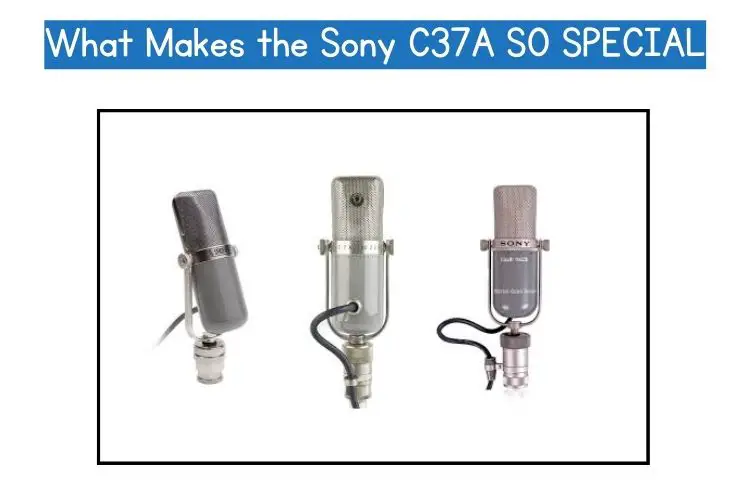Regarded as one of the best electric guitar microphones ever, the C37A is also that one mic that sounds great on everything. People who have used this mic will always say if you must buy only one microphone, let that mic be the Sony C37A.
A perfect mic for vocals—especially female vocals—because of its heavier bottom end that can fill out thinner voices and also add some lower-octave love to sopranos. The C37A has that natural and smooth feel that makes it seem like it applies its own natural compression to vocal takes.
It is almost impossible to hear anyone speak badly about this microphone. According to history, the Sony C37A was birthed out of necessity. It was in the mid-50s; this was at a time the Japanese audio market was in dire need of an affordable condenser mic of superb quality.
They needed a top-quality microphone that could compete against the dominant mic of the time which was the famous Neumann U47.
At that time, the Neumann U47 was outrageously expensive in Japan; this prompted the Japanese broadcaster NHK to begin the task of researching and developing an alternative microphone.
For some reason, they abandoned this project, and the research was then carried on by the Sony corporation. The result of this “continued research” was the outstanding and most beloved Sony C-37A.
The Sony C-37A—built from 1958 through the 1960s—is a vintage tube condenser microphone; it is widely known for its dark and rich tonality compared to the famous Neumann microphones made in the same era.
On why the C37A is special, it will be almost impossible for this mic not to be regarded especially by microphone enthusiasts. The C37A is everything (tonally, electrically, and physically) an awesome microphone should be.
Table of Contents
A brief history of the Sony C37A
In the Mid-50s, the Neumann U47 was the dominant mic in Japan and it was quite an expensive condenser microphone—although with high quality.
There was a longing in the Japanese audio market for a more affordable condenser microphone with high quality. This longing prompted the Japanese Broadcaster NHK to embark on a quest for an alternative mic for the Japanese audio market.
Unfortunately, the project was discontinued in the long run. It was later continued by Sony Corporation. Sony Corporation picked up the research abandoned by the Japanese Broadcaster NHK and invented the Sony C-37A.
The Sony C-37A was distinctive and a great alternative to the great Neumann U47 of the Era. In 1954, the Sony C-37A prototype was tried out in the NHK studio and the outcome was very reassuring.
The condenser mic was used to record a symphonic rehearsal conducted by a visiting conductor Herbert Von Karajan at the NHK studio. In 1955, the Sony C-37A was commercially available and received in the Japanese audio market.
It debuted in a Hi-Fi show in Los Angeles, America in 1958 and the sound was considered extremely satisfactory. The power supply of this tube condenser mic has been redesigned numerous times by Sony Corporation (from CP-2, CP-3, to CP-3B).
The name of this tube mic is derived from the size of the C-3 capsule. The C-3 capsule is 37mm across (1.45″). The capsule has a layer of gold 3 micrometres thick, on a 6-micron mylar diaphragm sputtered on the surface to make a conductive layer.
Sony C37A Frequency Response
The Sony C37A has a 30 to 16k Hz frequency response. The chief recording engineer at the Capitol, when the Sony C37A debuted in 1958, claimed it had the widest frequency band.
He said, “Never before have I seen such a wide frequency band or such a smooth response in the upper range.” The frequency response of the Sony C37A is a little wider than even its competitor and inspiration (the Neumann U47).
Sony C37A Specifications
Mic Type: Multi-Pattern Tube Condenser Microphone
Polar Pattern(s): Omnidirectional Cardioid, switchable, multipattern.
Electronics: Analog tube
Transducer Characteristics
Type: Condenser
Capsule diameter: 37mm
Diaphragm diam: 0mm
Diaph. thickness: 6 microns
Physical Characteristics
Weight: 560g / 19.75oz
Length: 192mm / 7.56”
Diameter
Interface(s): 3-pin XLR male (1)
Electrical Characteristics
Impedance
Max SPL
Self-noise: 200 Ω
Pricing & Availability
MSRP
Street
Availability: Discontinued
What makes the C37A So Special and Different from Other Tube Condenser Microphones?
The Sony C37A tube condenser microphone is special and different from other tube condenser mics for several reasons. The C37A is very innovative. It offers multiple settings on the power supply and a reflexive control behind the capsule for polar pattern adjustment.
This C37A tube condenser mic has a deceptively simple impedance circuit inside and a few resistors. The audio transformer and output coupling capacitor are located in the external power supply.
Sony C37A is one of the best tube condenser microphones that is great for acoustic guitar, electric guitar, vocals, toms, and overheads. It is capable of taming harsh guitar tones/sibilant sources and producing smokey period-sounding vocals.
The C37A is also very portable with an amazing shape and look. Regardless, the SPL of this microphone is quite high—it is generally regarded as a very sensitive microphone. Although we cannot exactly place these two in the same category, the Sony C37A has a lower output than the Shure SM57.
What sets the Sony C37A apart from other tube condenser mics is basically its sound—-it can be quite hard to describe how awesome this microphone sounds. Also, the C37A is quite a versatile microphone.
Another considerable factor that makes the C37A different is its affordability in price. Since the late 60s, the Sony C37A has been a high-quality mic with a very friendly price.
Review of the Sony C37A
The Sony C37A is one of the best condenser microphones that sounds great for everything ranging from electric to acoustic instruments.
The C37A also serves greatly for vocal recording due to its upper mid-dip and natural compression which delivers a beautiful sound.
In addition, this tube condenser mic will give you an excellent sound when used for instruments like the upright bass, banjo, strings, and horns. It has a pretty wide frequency response which makes it suitable for a wide variety of instruments and voices.
Pros and Cons of the C37A
| Pros | Cons |
| Easy to use | Very rare to find the original one. |
| Very reliable | |
| Superb features | |
| Excellent performance | |
| Smooth sounds | |
| Damping effects |
Does the Sony C37A Need Phantom Power?
No, the Sony C37A is a tube condenser microphone and does not need phantom power to operate. Phantom power is needed by Non-tube condenser microphones to operate whether it is a small or large diaphragm.
The Sony C37A operates with an external supply. This external power supply powers the internal circuitry also. Could provide up to 250v and more.
Where Are the C37A Microphones Made?
The Sony C37A tube condenser microphones were made in Japan.
Who Used the Sony C37A?
Frank Sinatra used the Sony C37A for his vocals recording and strings accompaniment. James Bay also used the Sony C37A in the Chaos and the Calm album. Jim Hendrix, Chris Botti, Theo Katzman, and Nat King Cole also used this mic.
Conclusion
The Sony C37A is special for its versatility in application and the quality of sound it produces.
The C37A can be used for recording both vocals and musical instruments including drums, acoustic instruments, electronic instruments, and even brass instruments.
This is the only condenser microphone that has a diaphragm and also features a tensioning mechanism.
Sony C37A is a do-all mic (tonally, electrically, and physically) which explains the very reason it is regarded to be so special.




![Fender Super Champ x2 vs. Blues Jr [Tones, Features, Versatality, etc..]](https://performerlife.com/wp-content/uploads/2022/09/fender-super-champ-x2-vs-blues-jr-211x150.jpg)
